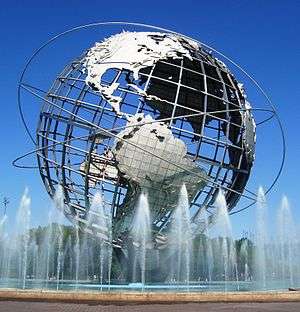Kew Gardens Hills, Queens
| Kew Gardens Hills | |
|---|---|
| Neighborhood in Queens | |
 A fruit and vegetable store on Main Street in Kew Gardens Hills. | |
|
Location within New York City | |
| Coordinates: 40°43′30″N 73°48′54″W / 40.725°N 73.815°WCoordinates: 40°43′30″N 73°48′54″W / 40.725°N 73.815°W | |
| Country |
|
| State |
|
| County | Queens |
| Named for | Kew Gardens, Queens; in turn named after Royal Botanic Gardens, Kew[1] |
| Area | |
| • Total | 3 km2 (1.0 sq mi) |
| Population (2010 United States Census)[2] | |
| • Total | 37,479 |
| Race | |
| • White | 53.9% |
| • Asian | 20.0% |
| • Hispanic | 14.8% |
| • Black | 7.6% |
| • Other | 3.7% |
| Economics | |
| • Median income | $95,847 |
| ZIP code | 11367 |
| Area code(s) | 718, 347, 929, and 917 |
Kew Gardens Hills is a middle class neighborhood in the middle of the New York City borough of Queens. The western border is Flushing Meadows-Corona Park, on the north is Jewel Avenue, on the south is Union Turnpike and to the east is Parsons Boulevard (or 164th Street). Kew Gardens Hills roughly encompasses ZIP code 11367. The neighborhood is part of Queens Community Board 8.
The neighborhood is located near several highways including the Long Island Expressway, Grand Central Parkway, Van Wyck Expressway, and the Jackie Robinson Parkway (Interborough). It is also served by several bus routes. Adjacent neighborhoods include Forest Hills to the west, Hillcrest to the east, Briarwood to the south, and Queensboro Hill to the north.
Geography
Kew Gardens Hills is situated in the southwestern corner of the area historically known as the Town of Flushing, in its 6th district.
As neighborhoods in the City of New York are not designated by the city,[3] there are multiple means to determine the geographical boundaries of the area:
- General borders: The western boundary of the neighborhood is considered to be Flushing Meadows-Corona Park, which is separated from the neighborhood by the Van Wyck Expressway. The southern playground of the park however is east of the Van Wyck Expressway, and is only accessible via an entrance along Park Drive East. Though part of the park, the playground is considered within Kew Gardens Hills. Prior to the building of the Van Wyck Expressway, the IND World's Fair Line ran along this route during the 1939 New York World's Fair.[4]
- Postal boundaries: Since 2003, when the United States Postal Services renamed the post office in ZIP code 11367 to the "Kew Gardens Hills Post Office",[5] the borders of the area for ZIP Code purposes extend from the south at Union Turnpike, to the north at the Horace Harding Expressway and east to Parsons Boulevard.[6] Prior to 2003 this Post office was called the Station C Post Office.[5] Although the post office is named "Kew Gardens Hills", the USPS still designates the city or town for purposes of addressing as "Flushing".[6]
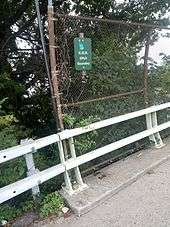 Boundary sign located over Flushing Meadows-Corona Park demarcating an Eruv boundary of Kew Gardens Hills
Boundary sign located over Flushing Meadows-Corona Park demarcating an Eruv boundary of Kew Gardens Hills - Other designations: Some areas, east of Parsons Boulevard and west of 164th Street, as well as south of Union Turnpike and north of the Grand Central Parkway are included in Kew Gardens Hills, by the NYC Department of Education,[7] historians,[8] the Kew Gardens Hills Eruv Committee, by residents or businesses themselves,[9] or by real estate brokers.[10][11]In these extended areas—with the exception of some zig-zag borders—residents north of 73rd Avenue use ZIP 11365, south of 73rd Avenue, ZIP 11366, and south of Union Turnpike, ZIPs 11432 and 11435.[6] These areas include the Pomonok, Electchester, and Parkway Village developments, among others. Despite the ZIP codes with the first three digits as "114" being originally designated in the postal city of "Jamaica", these areas of Kew Gardens Hills are within the geographical limits of the original Town of Flushing.[12] The present 164th Street runs along the original border between the 4th and 6th districts of the town of Flushing.[12]
Adjacent neighborhoods include Forest Hills to the west, Hillcrest to the east, Briarwood to the south, and Queensboro Hill to the north.
History
Early settlement
In the northwestern part of the neighborhood[13] was the location of the 120 acres (49 ha) Spring Hill Farm.[14] The farm was part of the Francis Lewis estate during colonial times. By 1762 the farm was owned by Colonel Thomas Willet, High Sheriff of Flushing,[15] and was sold to Cadwallader Colden, lieutenant governor for the Province of New York. In 1763 Colden built the Spring Hill House on the property. In 1783 the property was confiscated by the government because Cadwallader's son David was a loyalist to the monarchy. By 1894 the Durkee family owned the property and sold it to the Cedar Grove Cemetery Corporation. The Spring Hill House became the office of the Cedar Grove Cemetery, until the house was later destroyed by a fire.[14] Cadwallader Colden and Thomas Willet are among those who are buried on the property on what is now the grounds of the Mount Hebron Cemetery.[16][17][18]
In the 19th century the area of Kew Gardens Hills was known as Head of the Fly,[19] for its location at the headwaters of the Flushing Creek (or Flushing River). Fly or vly, being the Dutch word for swamp. One of the oldest roads through the area was called the Vleigh Road, and still exists today as Vleigh Place.[20]
Timothy Jackson operated a horse boarding stable near where the intersection of Park Drive East and Union Turnpike, or the Kew Gardens Interchange is today.[12][21] On what is now the Jamaica subway yard was previously a horse race course, built by Timothy Jackson, and was known as Whitepot Race & Track.[22] Although the train yard is not in Jamaica, it is named Jamaica because the yard feeds the subway lines which begin (or end) in Jamaica. This area was an extension of Timothy Jackson's Willow Glen Farm for which the farmhouse was located south of Union Turnpike in the neighborhood of Jamaica that is now called Briarwood.[23] In the 1750s, William Furman was the owner of the farm he named Willow Glen.[24] Today Willow Lake, at the southern end of Flushing Meadows–Corona Park, retains the Willow name.
The municipal government of the Town of Flushing, which dated back to colonial times, along with other municipal township governments in Queens County, was incorporated into the Borough of Queens on January 1, 1898. Later, the area, was named after Kew Gardens, which in 1909 was renamed after Royal Botanic Gardens, Kew in London, England in the United Kingdom.[1]
The area's earliest modern homes were built in 1917 off of Union Turnpike, but in the early 20th century, the area was known as Queens Valley and consisted mostly of farmland. By the 1920s many of the farms were sold to golf clubs or country clubs.[25] The golf courses that made up the area include the Spring Hill Golf Course, Queens Valley Golf Course, Pomonok Country Club, and Arrowbrook[26] Country Club. In 1939, the Arrowbrook Country Club was the home of the "Summer City Hall" of Mayor La Guardia.[27]
One road that ran through the area was called Quarrelsome Lane., which ran from Jamaica Road to Fresh Meadow Road; the road is now known as 75th Avenue. Jamaica Road, the most direct route between the villages of Flushing and Jamaica,[28] is now Kissena Boulevard and becomes Parsons Boulevard at the intersection of Quarrelsome Lane.[29]
Later years
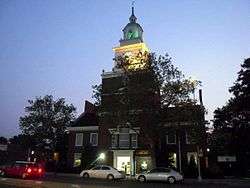
Growth to Kew Gardens Hills came when Kew Gardens, Queens, to the south, gained a subway line at Queens Boulevard in 1936 and Flushing Meadows–Corona Park, directly to the northwest of the neighborhood, hosted the 1939 New York World's Fair. Early residents were mostly German, Irish and Italian. Many were relocating from Brooklyn and Manhattan. The area was hilly and Kew Gardens was known as a prestigious Queens neighborhood and so developers changed its name from Queens Valley to Kew Gardens Hills.[30]
The first Queen of Peace mass took place in 1939.[20] Property along 144th Street, now part of Main Street, was seized by the city to complete the construction of Main Street from northern Flushing. Main Street was paved and bus routes began to serve the area in 1941. The Jewish Center of Kew Gardens Hills was established in 1941. The Queens County Savings Bank opened its branch in 1949 and local school, P.S. 164, also known as the Queens Valley School, also opened its doors that year.[31]
Main Street Cinemas—designed by architect Joseph Unger, who also designed the Trylon Theatre—opened in 1940 and operated by Interboro Circuit Inc. The 600 seat single screen theater was built at a cost of $75,000, and was dubbed one of the city's finest. The theater has since been subdivided into a six screen cineplex. Of the 39 theaters once operated by Interboro, Main Street Cinemas is the only theatre still in use today.[32][33]
On July 14, 1965, the neighborhood became infamous when five-year-old Eddie Crimmins Jr. and four-year-old Missy Crimmins vanished from their garden apartment at 150–22 72nd Drive. Missy's body was found the same day in a vacant lot on 71st Avenue at 162nd Street (the area where the 107th Precinct is located today.) Eddie's body was found five days later near 68th Drive and the entrance to the northbound Van Wyck Expressway. The children's mother, Alice Crimmins, was convicted in 1971, and imprisoned, in the death of her children. She was paroled in 1977.[34]
On September 16, 2010, an EF1 tornado touched down in Flushing Meadows-Corona Park, causing widespread damage to cars and homes in the Kew Gardens Hills area. John Bowne High School—located along Main Street at the edge of the CUNY Queens College campus, directly across from Mt. Hebron Cemetery—was the only New York City public school building to sustain physical damage related to the storm and was closed on the day after the storm.[35]
Demographics


Based on data from the 2010 United States Census, the population of Kew Gardens Hills was 37,479, an increase of 1,427 (4.0%) from the 36,052 counted in 2000. Covering an area of 873.05 acres (353.31 ha), the neighborhood had a population density of 42.9 inhabitants per acre (27,500/sq mi; 10,600/km2).[2]
The racial makeup of the neighborhood was 53.9% (20,184) White, 7.6% (2,839) African American, 0.2% (63) Native American, 20.0% (7,500) Asian, 0.1% (20) Pacific Islander, 0.4% (156) from other races, and 3.1% (1,169) from two or more races. Hispanic or Latino of any race were 14.8% (5,548) of the population.[36]
The neighborhood contains an established Orthodox and Haredi Jewish population and some Israelis, Bukharan Jews as well as smaller groups of Latinos, Koreans, Chinese, Indians, Afghanis and African Americans. Kew Gardens Hills is home to the largest concentration of Afghanis in the New York metropolitan area.[37]
There are several dozen houses of worship in Kew Gardens Hills, many of them Jewish.
Established in 1941, the Jewish Center of Kew Gardens Hills is the only traditional Conservative synagogue located in the heart of Kew Gardens Hills. By the 1950s, the Orthodox Jewish community began to take root. The first orthodox synagogue was formed in 1950 on Parsons Boulevard and 78th Road when the Jewish Center of Torath Emeth was formed with Rabbi Joel Laks as the spiritual leader. The following year, the Young Israel Congregation of Kew Gardens Hills was founded in 1951 with 15 families. That congregation now consists of 450 families.[38] Congregation Machzikei Hadas formed by Rabbi Yosef Gelernter on 73rd Avenue, is home to the first mikveh in Kew Gardens Hills. In March 1960, the City Council named a small park at Vleigh Place and Main Street as Freedom Square to commemorate the one hundredth anniversary of the birth of Theodor Herzl, founder of present-day Zionism.[28][39] As the neighborhood has a large Orthodox Jewish population, many residents have also moved from traditionally Jewish neighborhoods such as Crown Heights in Brooklyn.
Other houses of worship include the Roman Catholic Church Queen of Peace, located on Main Street at 77th Road. St. Nicholas of Tolentine is located on Parsons Boulevard behind east of Parkway Village. The Lutheran Church of the Ascension is located on Main Street just south of Union Turnpike. The Lutheran Church of the Redeemer, located on 65th Avenue near Parsons Boulevard, is also the facility used by the Korean Grace Community Church.
A sizable Muslim and Sikh population exists, most notably on the northern side with several stores catering to that population.
Education
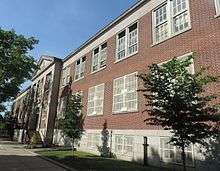
Public schools
Kew Gardens Hills' public schools, as are the public schools in all of New York City, are operated by the New York City Department of Education.
The following elementary schools (grades PK-5) are located within Kew Gardens Hills:
- P.S. 154
- P.S. 164 (Queens Valley)
- P.S. 165 (Edith K. Bergtram)
- P.S. 219 (Paul Klapper)
- P.S. 255
- The Queens College School for Math, Science and Technology (Q499)
- P.S. 201 The Discovery School for Inquiry and Research (Q201)
- PS/MS 200 – The Pomonok School & STAR Academy (Q200)
The following middle schools (grades 6–8) are located within Kew Gardens Hills:
- I.S. 250 The Robert F. Kennedy Community Middle School (Q250)
- P.S. 164 (Queens Valley)
- P.S. 219 (Paul Klapper)
- P.S. 255
- The Queens School of Inquiry (Q252)
- The Queens College School for Math, Science and Technology (Q499)
The following high schools (grades 9–12) are located within Kew Gardens Hills:
- John Bowne High School (Q425)
- P.S. 255
- The Queens School of Inquiry (Q252)
- Robert F. Kennedy Community High School (Q670)
- Townsend Harris High School at Queens College (Q525) Townsend Harris High School serves academically gifted students.
- North Queens Community High School, which serves troubled New York City youths who wish to obtain their high school diploma has been in the area since 2007.
Colleges and universities
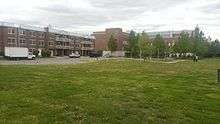
Two university campuses are located in Kew Gardens Hills. Located in the northern portion of Kew Gardens Hills is Queens College, a liberal arts college that is part of the City University of New York (CUNY) system. Queens College also serves as an important cultural institution for neighborhood residents with Colden Center for the Performing Arts and the Godwin-Ternbach Museum.[25]
Notable graduates of Queens College include native son Jerry Seinfeld, who was awarded an honorary doctorate in 1994, Ron Jeremy,[40] and Paul Simon.
Lander College, the men's college of Touro College, has a large campus on 150th Street at 75th Road.
Private schools
Yeshiva Chofetz Chaim (76th Road & 147th Street), Lander College for Men (75th Road and 150th Street, a division of Touro College), and Yeshivas Ohr HaChaim (71st Avenue & Main Street, a division of Touro College) are large yeshivas located in Kew Gardens Hills.
Other religious schools located in Kew Gardens Hills include St. Nicholas of Tolentine, Shevach High School (Main Street at 75th Road), Mesivta Yesodei Yeshurun, Yeshiva of Central Queens (70th Road at 150th Street), Yeshiva Ketana (Parsons Boulevard & 78th Road) and Solomon Schechter School of Queens (76-26 Parsons Blvd.)
Public libraries

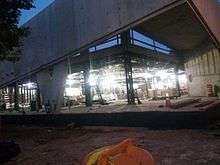
Queens Library operates the Kew Gardens Hills Branch at 72–33 Vleigh Place.[41] From 1954 until 1998 this library was called the Vleigh Branch.[42] In 2012, the section of Vleigh Place between 72nd Drive and 72nd Road, the block of the library building, was renamed Pat Dolan Way. Dolan was the president of the Kew Gardens Hills Homeowners Association until she was killed in a 2011 car crash. She was instrumental in securing funding for expansion of the library.[43] A 3000 sq. foot expansion of the Kew Gardens Hills branch began in March 2013 and the library reopened on September 6th 2017. A temporary library had been opened nearby at 71–34 Main Street during this time period.[41]
Queens Library also operates the nearby Pomonok Branch at 158–21 Jewel Avenue, east of Parsons Boulevard.[44]
The Benjamin S. Rosenthal Library,[45] on the Queens College campus, is a depository of U.S. government publications. The library is open to the general public for consultation and on-site use of these collections.[46]
Commerce
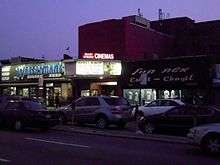
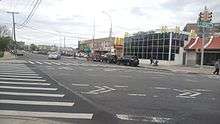
The commercial areas of the neighborhood include Main Street, Union Turnpike, Parsons Boulevard, and Kissena Boulevard. Main Street, in particular, is home to many Jewish-themed stores and Kosher restaurants. Many of the businesses along Main Street in Kew Gardens Hills close for Shabbat due to the area's large Jewish population.[30] Many businesses along Kissena Boulevard, on the other hand, have closed permanently due to an economic downturn.[47]
Emergency services
The majority of Kew Gardens Hills is served by the 107th Precinct of the New York City Police Department. The small portion of the area that is within Queens Community Board 7 is served by the 109th Precinct of the New York City Police Department.[48] Kew Gardens Hills is served by the Fire Department of New York City Engine 315 – Ladder 125, located on Union Turnpike at 159th Street. Emergency medical services are run by the FDNY Bureau of EMS, and the City of New York, Health and Hospitals Corporation operates the Queens Hospital Center (formerly known as Queens General Hospital) along 164th in the southeast corner of the area. Located on Main Street at Booth Memorial Avenue, only a few blocks north of Kew Gardens Hills in Queensboro Hill, is New York-Presbyterian Queens Hospital (formerly New York Hospital Queens and, prior to that, Booth Memorial Hospital). Hatzolah Volunteer Ambulance, Queens Division also serves the Kew Gardens Hills community, with 3 ambulances.
Politics
Except for an area west of Main Street and north of the cemetery which is located within the boundaries of Queens Community Board 7, the remaining areas of Kew Gardens Hills are within Queens Community Board 8.[49] The entire area of Kew Gardens Hills is part of New York City Council District 24.[50] In January 2014, Rory Lancman, was inaugurated as the 24th district's Councilmember, replacing James F. Gennaro, whom after serving three terms, was unable to run for re-election due to term limits.
Several civic or homeowners associations lobby on behalf of residents of the area. These associations include the Kew Gardens Hills Homeowners Civic Association, the Flushing on the Hill Taxpayers Association, Cedar Grove Civic Homeowners Association, Flushing Suburban Civic Association, Georgetown Mews, and Parkway Village Historical Society.[51]
Kew Gardens Hills is split among three districts in the New York State Assembly. These districts are 24; Assemblymember David Weprin, 25; Assemblymember Nily Rozic, and 27; Assemblymember Daniel Rosenthal. Kew Gardens Hills is also split among three districts in the New York State Senate. These districts are 16; Senator Toby Ann Stavisky, 14; Senator Leroy Comrie and 15; Senator Joseph P. Addabbo Jr. Finally, Kew Gardens Hills is split among two congressional districts in the United States Congress. These districts are New York's 5th congressional district and New York's 9th congressional district.
Transportation
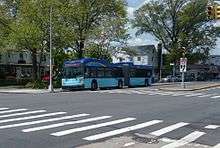

Main north-south arteries through and around the perimeter of the neighborhood are Main Street, Kissena Boulevard, 164th Street, and Parsons Boulevard. East-west arteries are Jewel Avenue, Union Turnpike, and the Horace Harding Expressway. Highways to and around the neighborhood include the Grand Central Parkway, Van Wyck Expressway, and the Jackie Robinson Parkway (Interboro Parkway), which all intersect at the Kew Gardens Interchange.
Local New York City Bus routes are the Q17, Q20A, Q20B, Q44 SBS, Q46, Q64 and Q88,[52] and the Q74 bus used to serve the neighborhood nearly exclusively until 2010.[53][54] MTA Bus routes are the Q25, Q34 and Q65.[52] All express buses from Kew Gardens Hills to Manhattan are operated under MTA Bus Company. Express routes include the QM1, QM4, QM5, QM6, QM7 and QM8.[52] However, no New York City Subway stations serve the neighborhood directly,[55] instead being accessible by local bus.[52]
Co-named streets
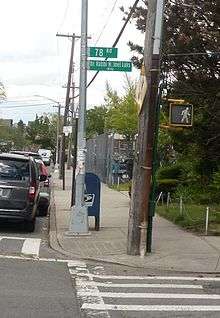
Because of the large Jewish population in Kew Gardens Hills, six streets in the neighborhood were named or co-named after notable Jewish persons:
- Freedom Square named in honor of Theodor Herzl's quest for a Jewish homeland
- Rabbi Kirshblum Triangle, named for the first Rabbi of the Kew Gardens Hills Jewish Center
- Dr. Rabbi H. Joel Laks Way on 78th Road between Parsons Boulevard and 160 Street, named for the founder of the first orthodox synagogue in the area
- Rabbi Avraham Schechter Way, named for a prominent resident of the community is located between 147th Street and 150th Street along 72nd Drive
- Haym Salomon Square (geometrically a triangle), across from the Kew Gardens Hills branch of the Queens Borough Public Library, named for the Revolutionary
- Abe Wolfson Triangle, named for an environmental activist and one of the founders of the Queens Historical Society is located along Kissena Boulevard near 75th Avenue.
Other streets named or co-named for non-Jewish persons include:
- Harry Van Arsdale, Jr. Avenue is the co-name for Jewel Avenue, after the labor leader whose union built Electchester.
- Pat Dolan Way, a block of Vleigh Place facing the Kew Gardens Hills Library. It is named after Pat Dolan, a longtime president of the Kew Gardens Hills Civic Association who was killed in 2011 in a car accident.[43]
- Pat Dolan Trail: A park trail cut into the marsh in Flushing Meadows Corona Park on the south side of Willow Lake. The trail extends from Mauro Playground in Kew Gardens Hills to the Grand Central Parkway Service road in Forest Hills.
Structures
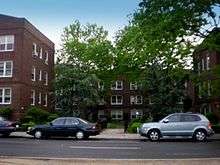
Kew Gardens Hills is a mixed neighborhood of single-family homes – detached or in rows – as well as three to six-story garden apartment buildings mostly built during the years immediately following World War II, such as Regency Gardens. These apartments are characterized by their lawns and internal pathways that give the complexes a small-neighborhood feel. There are several homes in Kew Gardens Hills that predate Main Street, whose property was subject to eminent domain in the 1930s to widen 144th Street into the Main Street extension from northern Flushing. A few public housing projects in one part of the neighborhood were also built. Other buildings in that area were built to house employees of certain unions, including the Electchester Co-operative Building, built for electrical employees in 1949 on what used to be the grounds of the Pomonok Country Club, which no longer houses electrical employees exclusively.[28]
Buildings
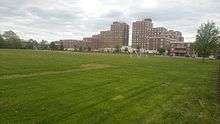
- The Godwin-Ternbach Museum is located on the grounds of Queens College. Founded in 1981 by art historian Frances Godwin and noted art restorer Joseph Ternbach, the Museum's mission has grown with the changing times from a teaching museum for the benefit of art students to a public museum that reaches out beyond the college campus.[56]
- Selma and Max Kupferberg Center for the Visual and Performing Arts is a concert hall located on the campus of Queens College, and provides an accessible and affordable facility to enrich the cultural environment of the region with classical and pop performances for general audiences.
- The Queens County Savings Bank building, constructed in 1954, is modeled after Philadelphia's Independence Hall. The building also has a full-size replica of the Liberty Bell. In 2005, the building was placed on the National Park Service, U.S. Department of Interior's National Register of Historic Places.[57]
- Parkway Village, designed by Leonard Schultze and Associates,[58] between Parsons Boulevard, Union Turnpike, and Grand Central Parkway, was built to house United Nations employees in the late 1940s. Some owners are seeking landmark historic status for the co-op.[59] Parkway Village was developed as a rental community with 685 units on 37 acres (150,000 m2) of rolling parkland in 1947. Today the buildings are in need of maintenance and upgrading, and the vegetation needs some management.[60]
- The Opal, a mid-rise luxury building built on the site of long-time vacant lots, opened in Kew Gardens Hills in November 2004; along with Lander College, it was built on marshland that is the source for Kissena Creek.[12]
- Six Spanish-style buildings built about 1908 for the New York Parental School are still in use on the Queens College campus today.[61] These buildings are the G Building, originally the infirmary for the NY Parental School; Colwin Hall; Delaney Hall; Frese Hall; the J Building, and Jefferson Hall, the administration building. The architecture of Jefferson Hall has earned it the description of turn of the [20th] century Central American capitol.[62]
- Adereth Eliyahu Congregation, built in 1983 and bisecting 147th Street, was awarded the Excellence in Design and Civic Value by the Queens Chamber of Commerce.[63]
Cemeteries
- Cedar Grove Cemetery. The entrance for automobiles is located at the intersection of Van Wyck Expressway and Horace Harding Expressway. A pedestrian entrance is located on Main Street near Gravett Road. Cedar Grove Cemetery was founded in 1894 as a non-sectarian cemetery. A major part of the cemetery was later to become the Mount Hebron Cemetery.
- Mount Hebron Cemetery uses the same roads as Cedar Grove cemetery but since 1909 has operated independently as a Jewish cemetery. As of 2012, over 217,000 burials have taken place at Mount Hebron.
- The Willett Family Burial Ground is located just inside the main gate to Mount Hebron Cemetery. Here, members of the Willet and Colden families, former owners of the property, are said to have been laid to rest. The stone of Elizabeth Willet, dated October 19, 1773 is still standing. Another stone dated 1722 is partially covered but visible.[64]
- Colored Cemetery, also known as the Troytown Cemetery, was a private cemetery in the estate of Troy Rantus, and was located on Cravett Place, which today is 149th Street between Melbourne Avenue and Gravett Road.[65][66][67] Wilson Rantus, writer, educator, and editor known as "The Anglo African," was an abolitionist instrumental in establishing a weekly black newspaper and a school for black children in Jamaica[68] was buried in this cemetery. This private family cemetery was established in 1853, but the land was sold by Troy's descendants in 1915. In 1952, the bodies were removed to Evergreens Cemetery in Brooklyn.[69] An 1861 gravestone attributed to abolitionist Wilson Rantus was found in a backyard on the site of the cemetery in June 2014.[70]
Parks and playgrounds
The New York City Department of Parks and Recreation maintains several playgrounds and parks in the Kew Gardens Hills area:


- Cedar Grove Playground. Located on Main Street at Gravett Road. The playground is next to JHS219.
- Electric Playground. Located along 164th Street in the Electchester development.
- Emerald Playground. Located on 164th Street off of Jewel Avenue.
- Flushing Meadows–Corona Park. The southern pedestrian and bicycle entrance to the Park is located on Jewel Avenue just south of Park Drive East. The Albert Mauro Playground near Willow Lake is accessible from Park Drive East near 73rd Terrace. An overpass over the Van Wyck Expressway connects the playground to Willow Lake. In Spring 2013, the NYC Parks Department renamed the trail around Willow Lake, the Pat Dolan Trail.[71] The trail is open to the public during daylight hours.[72]
- Freedom Square Playground. Located on Freedom Square at the intersection of Vleigh Place and Main Street.
- Judge Moses Weinstein Playground. The playground is located on Vleigh Place, north of Union Turnpike.
- Playground 75. Located on 160th Street at 75th Road.
- Pomonok Playground. Located on Kissena Boulevard at 65th Avenue, across the street from Queens College.
- Queens Valley Playground. Located on 137th Street at 76th Road. The playground is behind PS 164.
- Vleigh Playground. Located on 70th Road east of 150th Street, behind PS 165. The playground is located along the route of what was the Vleigh Road.
In popular culture
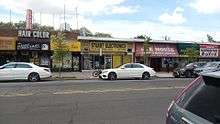
- The storefront of Stuart Electronics on Parsons Boulevard was featured in Season 14 Episode 14 of Law & Order. The real life owner of the store is Peter Guggenheim, father of Law & Order writer Mark Guggenheim.[73]
- Scenes from the 2000 movie Boiler Room were shot in Kew Gardens Hills. Kew Gardens Hills was referenced in the movie as well.[74]
- Kew Gardens Hills is home to Max and Mina's Ice Cream, named number 1 of the top 10 unique Ice Cream Parlors in America in Everybody Loves Ice Cream, the Whole Scoop on America's favorite treat by Shannos Jackson Arnold, Emmis Books, July 2004. Some Manhattan restaurants offer Max & Mina's Ice Cream on their dessert menus.[75] The Trivial Pursuit 20th Anniversary Edition featured the question "What kosher product is served in flavors like lox, corn on the cob, and horseradish, at Max & Mina's in Flushing, New York?"
- The 1939 PGA Championship was played at the Pomonok Country Club,[76] now the site of the Pomonok and Electchester housing in the northern section of Kew Gardens Hills. Henry Picard won the championship that year.
- Slackwire Sam Johnson's quarter-final act of Season 8 on America's Got Talent was filmed at Queens College during the summer of 2013.
- Scenes from Still Alice were filmed at Campbell Dome in Queens College.[77]
- Scenes from HBO's The Leftovers were filmed at Queens Hall.[77]
- Scenes from Saturday Night Live's skit Bern Your Enthusiasm, starring Larry David as Democrat Presidential Candidate Bernie Sanders, were filmed in front of Jefferson Hall and the Queens College Student Union buildings. The episode aired on NBC on February 6, 2015.
Notable residents
Notable residents past and present of Kew Gardens Hills include:
- Aaron Alexis (1979–2013), gunman in the 2013 Washington Navy Yard shooting, lived on 77th Road.[78]
- Ellen Barkin (born 1954), actress, grew up in Kew Gardens Hills.[79]
- Ralph Bunche (1903–1971), Nobel Peace Prize Laureate 1950, lived in Parkway Village.
- Robert Chartoff (born 1933), film producer, grew up in the neighborhood.[80]
- Cadwallader Colden (1688–1776), Lieutenant Governor for the Province of New York, maintained his summer residence at Spring Hill[81]
- Cadwallader David Colden (1769–1834), Politician. Mayor of New York from 1818–1821 was born in Spring Hill Farm[81]
- Fran Drescher (born 1957), actress, from The Nanny.[82] She lived at 147–49 72nd Avenue, Ambassador Gardens, and then at 150–58 71st Avenue, and worked at the Main Street movie theater as a teenager.[83]
- Bob Dylan (born 1941), musician, once lived in the neighborhood, near Queens College.[80]
- Gilbert Eisner (born c. 1940), former fencer, who won the épée title at the 1962 U.S. Fencing Championships[84]
- Betty Friedan (1921–2006), activist, feminist and writer, lived in Parkway Village in the early 1950s.
- Ashrita Furman (born 1954), set more than 160 official Guinness records.[85]
- Art Garfunkel, musician, lived at 136–58 72nd Avenue.[86]
- Lenny Hambro (1923–1995), jazz musician, lived on 77th Road.[87]
- Fiorello La Guardia (1882–1947), former congressman and mayor of New York City maintained a summer residence in the area.[88]
- Martin Landau (born 1928), actor, grew up in Kew Gardens Hills.[80]
- Michael Landon (1936–1991), actor, grew up in Kew Gardens Hills.[89]
- Rose Meth (1925–2013), surviving participant in the October 7, 1944 "Sonderkommando uprising"[90]
- Mark Olf (1905–1987), Jewish folksinger and recording artist, lived in Kew Gardens Hills.
- Daniel Rosenthal (born 1991), politician who has since 2017 represented the 27th District in the New York State Assembly and was the Assembly's youngest member when he took office.[91]
- Michael Simanowitz (1971–2017), New York State Assembly Member, lived in the Electchester development.
- Paul Simon (born 1941), singer, songwriter and musician, lived at 137–62 70th Road[86]
- Paul Stanley (born 1952), lead singer of KISS, lived on 75th Road near Main Street[92][93]
- Kalman Topp (born 1972), rabbi, educator and author, lived on 72nd Crescent.
- Leroy Watson, rapper, makes his home in Kew Gardens Hills.[94]
- Moses M. Weinstein (1912–2007), lawyer and politician, who has a playground named for him.[95]
- Roy Wilkins (1901–1981), civil rights leader who headed the NAACP. He lived at 147–15 Village Road in Parkway Village. A major park in south Queens now bears his name.
References
- 1 2 "Next to the L.I.R.R. Tracks; Five 2-Family Houses For Kew Gardens". The New York Times. April 24, 1994. Retrieved September 27, 2010.
In 1909, when train service began on the Long Island Rail Road, the northerly section of the Man property was renamed Kew Gardens, also after a section of London.
- 1 2 Table PL-P5 NTA: Total Population and Persons Per Acre - New York City Neighborhood Tabulation Areas*, 2010, Population Division - New York City Department of City Planning, February 2012. Accessed June 16, 2016.
- ↑ "NYC Department of City Planning". Nyc.gov. Retrieved 26 July 2018.
- ↑ "1939 Subway Map". NYCSubway.org. Retrieved November 6, 2014.
- 1 2 "Post office on Main Street renamed for neighborhood". Times Ledger. June 26, 2003. Retrieved May 11, 2012.
- 1 2 3 "United State Postal Service". Usps.com. Retrieved November 6, 2014.
- ↑ "NYC DOE Neighborhood Search". NYCDOE. Retrieved November 6, 2014.
- ↑ "Kew Gardens Hills, Queens", Forgotten NY. Kevin J. Walsh. Retrieved November 6, 2014.
- ↑ "Kew Motor Inn". Kew Motoe Inn. Retrieved November 6, 2014.
- ↑ "Kew Gardens Hills". NY Bits. Retrieved November 6, 2014.
- ↑ "Hotels Near Pomonok". Hotelplanner.com. Retrieved November 6, 2014.
- 1 2 3 4 "Beers 1873 Map". David Rumsey. Retrieved November 6, 2014.
- ↑ "Willet Family History". Scribd.com. p. 18. Retrieved November 6, 2014.
- 1 2 "Cedar Grove Playground". Nycgovparks.gov. Retrieved November 6, 2014.
- ↑ The History of the Several Towns, Manors, and Patents of the County of Westchester: From Its First Settlement to the Present Time, Volume P.275 (Google eBook)
- ↑ "Colden Family Cemetery". Findagrave.com. Retrieved November 6, 2014.
- ↑ "New York City Cemetery Project". Nycemetery.wordpress.com. Retrieved November 6, 2014.
- ↑ "Thomas Willet Jr". Findagrave.com. Retrieved November 6, 2014.
- ↑ "Colton 1853 Map of 33 Miles around NYC". Davidrumsey.com. Retrieved November 6, 2014.
- 1 2 Tina Morales. "Kew Gardens Hills: Articles pertaining to it and its history". Kghca.org. Retrieved May 23, 2012.
- ↑ "Beers 1873 Queens County Business Notices". Davidrumsey.com. Retrieved November 6, 2014.
- ↑ "Colonial House Of 1750 To Be Razed For New Parkway; Legend Says That General Hove Camped There In 1776". Queensnewyork.com. Retrieved November 6, 2014.
- ↑ "NYC Park Department Queens Valley Playground". Nycgovparks.org. Retrieved November 6, 2014.
- ↑ "NYC Parks: Queens Valley". Nycgovparks.org. Retrieved November 6, 2014.
- 1 2 "Kew Gardens Hills". Longislandexchange.com. Archived from the original on March 15, 2009. Retrieved July 5, 2009.
- ↑ "New York Public Library". Digitalgallery.nypl.org. Retrieved June 11, 2012.
- ↑ "New York Evening Post" (PDF). Fultonhistory.com. Retrieved November 6, 2014.
- 1 2 3 "Forgotten NY Neighborhoods: Kew Gardens Hills". Forgotten-ny.com. Retrieved July 5, 2009.
- ↑ "1910 Map of Queens". Bklyn-genealogy-info.com. Retrieved November 6, 2014.
- 1 2 "If You're Thinking of Living in Kew Gardens Hills; Tranquil Enclave, Especially on Saturday". The New York Times. January 13, 2002. Retrieved July 5, 2009.
- ↑ Gottlieb, Jeff. "The Kew Gardens Hills Five" (PDF). Queens Central Historical Association. Retrieved July 5, 2009.
- ↑ "Cinema Treasures". Retrieved January 28, 2016.
- ↑ "Cinema Treasures". Retrieved January 28, 2016.
- ↑
- Archived March 2, 2010, at the Wayback Machine.
- ↑ "City Workers Clear Debris in Aftermath of Fierce Storm". The New York Times. Retrieved November 6, 2014.
- ↑ Table PL-P3A NTA: Total Population by Mutually Exclusive Race and Hispanic Origin - New York City Neighborhood Tabulation Areas*, 2010, Population Division - New York City Department of City Planning, March 29, 2011. Accessed June 14, 2016.
- ↑ "All Peoples Initiative" (PDF). Bcnychurchplanting.org. Archived from the original (PDF) on December 3, 2013. Retrieved June 12, 2012.
- ↑ Halapid, Official Publication of YIKGH November–December 2010 Issue p.23-27
- ↑ "Freedom Square Playground Map : NYC Parks". www.nycgovparks.org.
- ↑ Hevesi, Dennis (June 3, 1994). "Commencements; Queens College Graduates Hear a Wistful Seinfeld". The New York Times. Retrieved July 8, 2007.
Mr. Seinfeld, after receiving an honorary doctorate in humane letters, told the graduates, who responded with knowing laughter: 'I spent several wonderful years here. The best spot I ever got was in my junior year. It was right out here on Kissena Boulevard near Melbourne Avenue. I didn't even have to parallel; I pulled right in. It was a beautiful spot.'
- 1 2 "Queens Library". Queenslibrary.org. Retrieved November 6, 2014.
- ↑ "In The Nabes Health Is Focus At Fair". Archived from the original on July 13, 2012. Retrieved May 21, 2012.
- 1 2 "Pat Dolan's legacy immortalized on street sign". Timesledger.com. Retrieved November 6, 2014.
- ↑ "Queens Library". Queenslibrary.org. Retrieved November 6, 2014.
- ↑ "Queens College Library". Qcpages.qc.edu. Retrieved November 6, 2014.
- ↑ "Queens College Library Mission Statement". Qcpages.qc.edu. Retrieved November 6, 2014.
- ↑ "Kissena Curve' closings worry Kew Gardens Hills". Zwire.com. January 29, 2009. Retrieved July 5, 2009.
- ↑ "NYPD : Precinct Finder". Nyc.gov. Retrieved November 6, 2014.
- ↑ "Queens Community Boards". Nyc.gov. Retrieved November 6, 2014.
- ↑ "District 24 Map". Gotham Gazette. Retrieved June 1, 2012.
- ↑ "Parkway Village Historical Society". Queensciviccongress.org. Retrieved June 1, 2012.
- 1 2 3 4 "Queens Bus Map" (PDF). Metropolitan Transportation Authority. December 2017. Retrieved April 24, 2018.
- ↑ MTA Regional Bus Operations. "Q74 bus schedule" (PDF).
- ↑ "Queens Bus Map" (PDF). nycityhealth.com. Metropolitan Transportation Authority. September 1999. Archived from the original (PDF) on September 16, 2015. Retrieved July 6, 2015.
- ↑ "Subway Map" (PDF). Metropolitan Transportation Authority. January 18, 2018. Retrieved January 18, 2018.
- ↑ "Godwin-Ternbach Museum on-line". Qcpages.qc.cuny.edu. Retrieved November 6, 2014.
- ↑ "National Register of Historic Places : Search for Queens County Savings Bank". Nrhp.focus.nps.gov. Retrieved November 6, 2014.
- ↑ New York Year by Year: A Chronology of the Great Metropolis, Jeffrey A. Kroessler, p. 255
- ↑ "Parkway Village owners divided on landmark designation". New York Daily News. October 24, 2008. Retrieved July 5, 2009.
- ↑ "Parkway Village Placed on Historic Sites Register". Timesledger.com. Retrieved November 6, 2014.
- ↑ "Queens College 10 Year Sustainability Plan" (PDF). Qc.cuny.edu. Retrieved November 6, 2014.
- ↑ AIA Guide To NYC. Books.google.com. p. 796. Retrieved November 6, 2014.
- ↑ Queens Chamber of Commerce
- ↑ "Willett Family Burial Ground". New York City Cemetery Project. Retrieved November 6, 2014.
- ↑ "1931 Map of Private Cemeteries in Queens". bklyn-genealogy-info. Retrieved November 6, 2014.
- ↑ "Fairchild Cemetery Manual". Ebooksread.com. p. 10. Retrieved November 6, 2014.
- ↑ "City of New York Description of Private and Family Cemeteries" (PDF). Longislandgenealogy.com. p. 60. Retrieved November 6, 2014.
- ↑ "NYS Literary Tree". Nyslittree.org. Retrieved November 6, 2014.
- ↑ The Graveyard Shift by Carolee Inskeep
- ↑ "Grave mystery: abolitionist's tombstone turns up in Queens backyard!". NY Daily News. Retrieved November 6, 2014.
- ↑ "Renaming of Trail in Honor of Pat Dolan : Photo Gallery : New York City Department of Parks & Recreation : NYC Parks". Nycgovparks.org. Retrieved November 6, 2014.
- ↑ "KGHCA News and Special Events". Kghca.org. Retrieved November 6, 2014.
- ↑ "Peter Guggenheim's Life of Fixing Radio Scanners". The New York Times. Retrieved November 6, 2014.
- ↑ http://www.subzin.com/search.php?title=Boiler+Room&imdb=&q=Kew+Gardens+Hills&search_sort=Popularity&genre=-1&type=All. Retrieved June 14, 2012. Missing or empty
|title=(help) - ↑ Archived March 20, 2009, at the Wayback Machine.
- ↑ "The 85th PGA Championship / News / Ruling the Empire State(7/24/03)". Pga.com. Retrieved November 6, 2014.
- 1 2 "Entrepreneurial department adds money and recognition to QC". Theknightnews.com. Archived from the original on July 25, 2014. Retrieved November 6, 2014.
- ↑ "D.C. Shooter Has Strong Ties to Queens". Timesledger.com. Retrieved November 6, 2014.
- ↑ "Ellen Unloads". The New York Times. Retrieved November 6, 2014.
- 1 2 3 "The Best Queens Celebrities 2002". Queens Tribune. Archived from the original on November 1, 2002. Retrieved July 5, 2009.
- 1 2 "NYC Park Department Cedar Grove Playground". Nycgovparks.org. Retrieved November 6, 2014.
- ↑ Firestone, David (September 18, 1994). "For Queens, a Place in the Sun; Hollywood Is Suddenly Zooming In, With a Vengeance". The New York Times. Retrieved January 27, 2008.
Ms. Drescher, who actually comes from Kew Gardens Hills, may be the most deliberately colorful of the lot, but she is hardly alone in celebrating the showbiz ascendancy of her native land.
- ↑ "Fran Drescher To Debut New Daytime Talk Show — www.qgazette.com — Queens Gazette". Qgazette.com. Retrieved November 6, 2014.
- ↑ Werden, Lincoln A. "Eisner Captures Title In Fencing; Former N.Y.U. Star Takes U.S. Epee Championship Wins Fence-Off Richards Finishes Second", The New York Times, July 4, 1962. Accessed February 9, 2018. "Gil Eisner, a commercial artist from Kew Gardens Hills, Queens, became a new champion in an ancient sport last night. The 22-year-old athlete captured the epee title in the national fencing championship staged at the Park Sheraton Hotel."
- ↑ Kilgannon, Corey (June 12, 2003). "Got Milk? Hula Hoop? It's a Record!; He's Guinness's King Of Strange Feats, All for Inner Peace". The New York Times. Retrieved November 2, 2007.
- 1 2 Haberman, Clyde (December 5, 2003). "NYC; 50-Something, But Feelin' Forever Groovy". The New York Times. Retrieved October 27, 2007.
Quite a few numbers that Mr. Simon wrote, both for Simon and Garfunkel and for himself as a solo performer, are punctuated with New York references. That is only natural, considering that he and Mr. Garfunkel both grew up in Kew Gardens Hills, Queens.
- ↑ Michels-Hambro, Lynn. Interview, March 23, 2008.
- ↑ "NYC Parks Department Queens Valley Playground". Nycgovparks.org. Retrieved November 6, 2014.
- ↑ "History Topics: Queens Timeline – 1990s". Greater Astoria Historical Society. Retrieved February 6, 2008.
- ↑ "Names Not Numbers". Namesnotnumbers.org. Retrieved November 6, 2014.
- ↑ Biography of Daniel Rosenthal, New York State Assembly. Accessed January 27, 2018. "Daniel is the youngest sitting member of the New York State Legislature. He is a graduate of Lander College for Men and resides in Kew Gardens Hills."
- ↑ "Paul Stanley Still Feels Like a 'Freak'". Noisecreep. Retrieved November 6, 2014.
- ↑ "KGH History". Kghca.org. Retrieved November 6, 2014.
- ↑ "A Rapper for Diddy Finds a Home That's Just Dandy". The New York Times. Retrieved November 6, 2014.
- ↑ "Honoring Justice Moses M. Weinstein". Capitol Words. Archived from the original on July 9, 2012. Retrieved November 6, 2014.
External links

